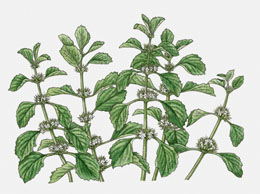A species of the mint family, the horehound herb is endemic to Europe, but can now be found throughout North and South America. Like most herbs, this one is also a storehouse of benefits.

Also known as hoarhound, marrubium, marvel, and white horehound, this perennial herb of the mint family grows in places like open meadows, pastures, waste lands, and even on road sides. It can be found in most parts of coastal United States, Canada, and Great Britain. Germany, France, and the European continent are also the places where this plant is usually found.
The plant has wrinkled leaves, bearing a rough texture on the top, while a woolly one on the underside of the lamina. Right from being an ingredient in candies to cough drops or syrups, horehound has been a traditional medicinal herb, which has been in use since ancient Greek and Egyptian times. Due to its utterly bitter taste, many prefer to take it in the form of a candy or syrup. However, some also prefer to take it in the form of a tea.
Health Benefits
Drinking a cup of warm tea prepared from horehound herb is good enough to loosen the accumulated phlegm in the lining of the throat, lungs, and sinuses. Apart from this, the nasty headache that occurs due to a sinus infection can also be taken care of by taking some hot sips of tea infused with horehound. It is known to alleviate pain associated with a sore throat and soothes inflamed lung tissues caused by cold and flu. Its use will prove to be beneficial for children and adults affected by wheezing cough, whooping cough, chronic bronchitis, hacking cough, bronchial asthma, etc.
It can also be used for increasing appetite and improving function of the stomach and the digestive system. It is believed that it helps in improving the regularity of cardiac contraction. Adults and children who often suffer from respiratory problems can be treated with this herb, as it works as an expectorant and a natural tonic. Even bites like those of the rattlesnakes and rabid dogs can be addressed. However, for such purposes, the herb must be used in conjunction with
Plantago lanceolata.
Side Effects
Reported side effects in case of an overdose include diarrhea, hypoglycemia, contact dermatitis, hallucinations, delirium (defined as a state wherein the affected person exhibits violent mental agitation), dry mouth, dilated pupils, restlessness and in some cases, even coma. Since it may cause an increase in the stomach acid in the body, it must not be taken by people suffering from peptic ulcers or gastritis. The seeds may turn out to be poisonous, especially in case of children. Expectant and nursing mothers must avoid its use. It must not be used in conjunction with cold medications and medications which tend to lower blood pressure. Caution must be exercised by people who intend to use it, especially those who are suffering from cardiovascular disease. In fact, it would be best to consult your doctor or herbal practitioner before you start using it.
On a concluding note, here is an easy tip on making horehound tea. Let two and a half teaspoon of fresh dried horehound herb steep in a pint of boiling water. Wait for 40 - 45 minutes and then strain it. Flavor it with lemon juice, and take the tea in a lukewarm state.
Disclaimer:
The information provided in this article is solely for educating the reader. It is not intended to be a substitute for the advice of a medical expert or herbalist.






 Also known as hoarhound, marrubium, marvel, and white horehound, this perennial herb of the mint family grows in places like open meadows, pastures, waste lands, and even on road sides. It can be found in most parts of coastal United States, Canada, and Great Britain. Germany, France, and the European continent are also the places where this plant is usually found.
Also known as hoarhound, marrubium, marvel, and white horehound, this perennial herb of the mint family grows in places like open meadows, pastures, waste lands, and even on road sides. It can be found in most parts of coastal United States, Canada, and Great Britain. Germany, France, and the European continent are also the places where this plant is usually found.